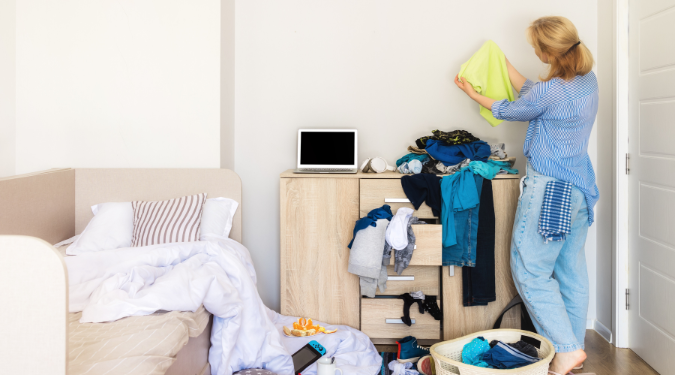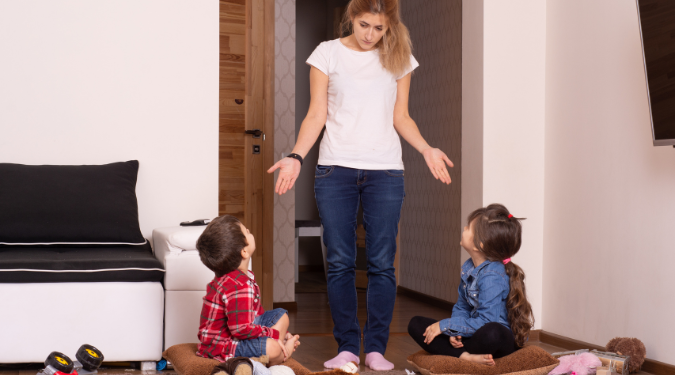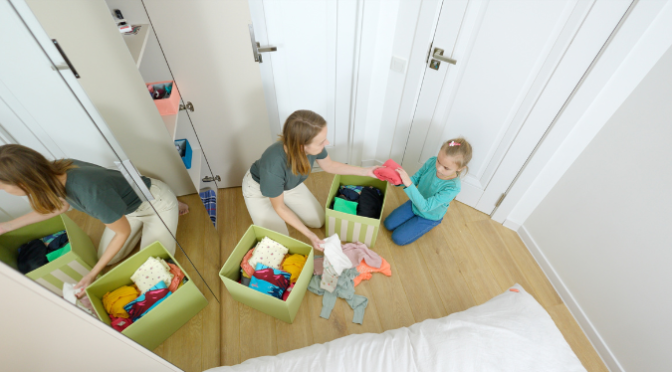As a home organiser, one of the most rewarding (and sometimes challenging) tasks is helping families create tidy, functional spaces. Kids’ rooms, in particular, can be a chaotic blend of toys, clothes, books, and sentimental items that seem to multiply overnight. While the task of decluttering a child’s room can feel overwhelming, involving kids in the process is essential for long-term success and teaching valuable organisational skills.
In this blog, we’ll explore how to get kids involved in decluttering their rooms. By creating a fun, engaging, and structured experience, you can turn the process into a learning opportunity that sets the stage for lifelong organisation skills. Let’s dive in!
1. Start with a Conversation
Before you even start decluttering, it’s crucial to have an open conversation with your child. Kids may not naturally understand the benefits of decluttering, but involving them in the discussion helps them feel part of the process. Instead of just announcing that their room is getting organised, explain why it’s important for both them and the family.
- Explain the benefits: Tell your child how a tidy room will make it easier to find their favourite toys, books, or clothes. Mention that it will create more space for play and relaxation.
- Make it a positive experience: Emphasise that it’s not about getting rid of everything but making space for things that truly matter. Highlight that they can keep what they love while donating or recycling the things they no longer need.
This conversation should be calm, upbeat, and free of judgment. The goal is to set a positive tone for the decluttering process, so your child feels excited rather than overwhelmed.
2. Set Clear Goals
A cluttered room can be a visual overload for both parents and children. It’s easy to get lost in the mess, so having a clear plan in place is essential. As a home organiser, breaking down the task into smaller, manageable steps is key to success.
- Set specific goals: Ask your child what areas of their room bother them the most. Is it the toy shelf that’s overflowing? The wardrobe that’s hard to close? Set goals that are realistic and achievable based on the space available.
- Create a checklist: Having a visual checklist can help kids see their progress. Whether it’s a simple list or a series of pictures, seeing completed tasks will motivate your child to continue working. You can also divide tasks into categories like “toys,” “books,” “clothes,” and “art supplies.”
Setting goals not only provides direction but also gives your child a sense of accomplishment when each task is completed. This structured approach will help them stay focused and understand the benefits of keeping a tidy room in the future.

3. Make It Fun and Engaging
Decluttering doesn’t have to be a chore. Turning the process into a game can help keep kids engaged and make the experience enjoyable. A playful approach not only reduces resistance but also encourages them to take ownership of their space.
- Turn it into a race: For younger kids, make it a timed activity. “How many toys can you put in the donation box in 5 minutes?” This not only makes the process fun but also helps them focus on a single task for a set amount of time.
- Use rewards and praise: Offer small rewards for completed tasks. This could be as simple as a sticker or extra playtime. Positive reinforcement is key to keeping kids motivated.
- Create a donation challenge: Ask your child to pick five toys or books to donate, and frame it as a challenge. You could even suggest that they take part in selecting a charity or family in need to receive the items.
By transforming decluttering into an enjoyable activity, you’ll make the process something your child looks forward to, rather than resists. This playful approach is one of the best ways to get kids involved in organising their rooms.
4. Empower with Decision-Making
One of the most important aspects of involving kids in decluttering is giving them the power to make decisions. Children may hold onto things due to sentimental value or the idea that they might need them someday. While it’s essential to guide them, it’s also important to allow them the space to decide what stays and what goes.
- Use guiding questions: Ask your child simple, open-ended questions like, “Do you still play with this?” or “Does this make you happy?” These questions allow them to reflect on their relationship with the item, making it easier for them to decide.
- Create categories: Help your child break down their belongings into categories: “Keep,” “Donate,” “Recycle,” and “Toss.” Giving them clear choices allows them to make decisions without feeling overwhelmed.
- Set limits: If your child has too many stuffed animals or action figures, agree on a reasonable number to keep. For example, “Let’s pick your 10 favourite stuffed animals and donate the rest.” This teaches kids that it’s okay to let go of some things in order to make room for others.
When children are empowered to make decisions, it fosters a sense of responsibility and ownership over their space. Teaching kids organisational skills in this way is vital for their growth.
5. Break It Down into Small, Manageable Tasks
Decluttering an entire room in one go can be a daunting task, both for parents and kids. To avoid overwhelming your child, break the process into smaller, more manageable steps.
- Tackle one area at a time: Start with one part of the room, like a shelf or drawer. Focusing on small sections makes the process less overwhelming and allows your child to see immediate progress.
- Sort by category: Instead of tackling the whole room, sort items by type. For example, start with books, then move on to clothes, followed by toys. This method reduces distractions and helps your child stay focused on one thing at a time.
- Take breaks: Kids have short attention spans, so be sure to schedule breaks every 30 minutes or so. Use this time to stretch, have a snack, or do something fun before diving back into the decluttering process.

By breaking down the decluttering process, you can keep things manageable for your child and prevent burnout. This is a critical step when organising kids’ rooms, as it helps avoid frustration.
6. Use Visual Aids for Organisation
Young children, especially those who are just starting to learn about organisation, can benefit from visual aids. Visual tools make the decluttering process clearer and easier for kids to understand.
- Create a “Keep” box: Use a large, clear bin or box labelled “Keep” where your child can place their most-loved items. You can also label the other boxes as “Donate,” “Recycle,” and “Toss” to create a clear distinction between categories.
- Use pictures for younger kids: For younger children who might not be able to read, use pictures to represent categories. For example, pictures of toys, books, and clothes can help them easily identify where items belong.
- Label storage bins: Help your child organise their belongings with labelled storage bins. Clear bins are ideal, as they allow your child to see what’s inside without making a mess. Use labels with pictures for easy identification.
Visual aids not only make the process easier to follow but also help kids develop a strong understanding of organisation that they can carry into adulthood. This method is especially helpful when teaching kids organisational skills.
7. Teach Long-Term Organisation Skills
Decluttering is not just about tidying up for a day; it’s about teaching your child valuable organisational skills that will last a lifetime. The goal is to create habits that help them maintain an organised space in the long run.
- Incorporate daily routines: Teach your child to spend a few minutes each day tidying up their room. Encourage them to make their bed in the morning, put away their toys before dinner, and return books to the shelf after reading.
- Use the “One In, One Out” rule: Teach your child that for every new item they bring into their room, one old item needs to be donated or tossed. This keeps the room from becoming cluttered in the future.
- Review and refresh regularly: Schedule regular check-ins every few months to reassess the room. This can be a fun way to ensure that things are still organised and that any new clutter is dealt with promptly.
By involving your child in the organisation process and teaching them good habits, you’re setting them up for a lifetime of organisation.

Conclusion
Getting kids involved in decluttering and organising their own rooms can be a rewarding experience for both parents and children. By using clear goals, breaking tasks into manageable steps, and making the process fun, you’ll help your child develop lifelong organisational skills. Not only will they learn how to keep their space tidy, but they’ll also gain valuable lessons in decision-making, responsibility, and empathy.
As a home organiser, your role in guiding the process is essential, but the ultimate success lies in empowering your child to take ownership of their space. With the right mindset and approach, you can turn decluttering into an enjoyable, educational experience that benefits the whole family. By instilling these organisational habits, your child will learn how to maintain a tidy space, both now and in the future.
Ready to create a clutter-free space for your kids? Contact us today to get started with expert organising tips and solutions!
Call us at 03 8583 9103, email nancy@homeorganisers.com.au, or visit our website at homeorganisers.com.au. Let’s transform your home together!
Home organisers assist by creating a tailored plan for sorting, decluttering, and organising kids’ rooms. They break the process into simple steps, help sort items into categories, and introduce easy-to-use storage solutions like bins, shelves, and labels, making it fun and manageable for kids. Effective strategies include decluttering first, then using clear bins or labelled storage for toys, books, and clothes. Creating activity zones (like a reading nook or toy area) and establishing daily routines, such as tidying before bedtime, helps maintain organisation. Involve kids by explaining the benefits of decluttering, empowering them to decide what to keep, donate, or toss. Make it a fun activity by setting challenges, using rewards, and creating clear categories to guide the process. Teaching organisational skills early helps kids develop responsibility, boosts their confidence, reduces stress, and creates lifelong habits. It also improves focus and creates a calm, structured environment for play and study. Yes, home organisers can set up organised play zones, sort through toys, and implement practical storage solutions. They guide the process to ensure the playroom remains fun, functional, and easy for kids to maintain. Home organisers use tools like clear bins, baskets, shelving, and multi-functional furniture to maximise space. Labels and visual aids help kids maintain organisation, while under-bed storage and vertical solutions optimise room layout. A kid-friendly storage system includes easy-to-reach bins and labelled storage. Clear containers help kids see what’s inside, while simple routines for putting things away maintain the system long-term. Involving kids in the setup encourages them to take responsibility. Make decluttering fun by turning it into a game, setting challenges (e.g., “donate five toys”), and offering rewards like stickers or extra playtime. Playing music can also keep the energy up and make the process more engaging. Home organisers set up systems that kids can easily maintain, teach daily routines for tidying, and provide ongoing support. Regular check-ins ensure the system adapts as your child grows, keeping their space organised long-term. Handle sentimental items by creating a memory box for cherished items or taking photos of things that can’t be kept. Encourage your child to reflect on each item’s value, making the process gradual and positive.FAQs about Get Kids Involved in Decluttering and Organising Their Own Rooms


